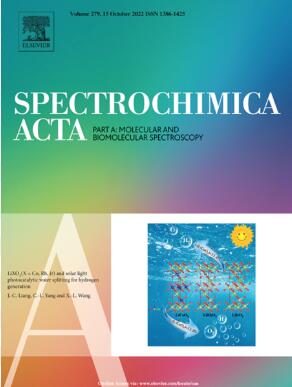Naked-eye trackable fluorescence-enhanced probe for real-time imaging of biological thiols in living cells
IF 4.3
2区 化学
Q1 SPECTROSCOPY
Spectrochimica Acta Part A: Molecular and Biomolecular Spectroscopy
Pub Date : 2025-06-27
DOI:10.1016/j.saa.2025.126618
引用次数: 0
Abstract
Biothiols, comprising cysteine (Cys), homocysteine (Hcy), and glutathione (GSH), constitute the predominant thiol pool in biological systems and serve as critical regulators of redox homeostasis. Despite their physiological significance, these species exhibit marked susceptibility to oxidative stress, with resultant concentration dysregulations being implicated in the pathogenesis of various disorders including neoplastic progression, cardiovascular abnormalities, and neurodegenerative conditions. To address the critical need for reliable biothiols monitoring in living systems, we present a rationally engineered hemicyanine-based fluorescent probe (MCY-NB) employing a turn-on fluorescence mechanism. The proposed probe possesses excellent fluorescence properties, biocompatibility, and ease of operation, making it an essential prerequisite for its application in biological systems. Compared with other reports, this study is capable of quantitatively detecting total biothiols to meet the clinical demand for biothiols monitoring in samples. Furthermore, the fluorescent probe can selectively detect total biothiols against a series of amino acids with a broad concentration range (1–250 μM). Moreover, the successful realization of naked-eye visualization of biothiols through this strategy provides a highly attractive alternative for portable outdoor detection. Most critically, the fluorescence probe can realize the dynamic monitoring of intracellular biothiols fluxes through its permeability, which holds potential for application in the diagnosis of diseases associated with biothiols imbalances.

用于活细胞中生物硫醇实时成像的裸眼可追踪荧光增强探针
生物硫醇,包括半胱氨酸(Cys)、同型半胱氨酸(Hcy)和谷胱甘肽(GSH),构成了生物系统中主要的硫醇库,并作为氧化还原稳态的关键调节剂。尽管具有重要的生理意义,但这些物种对氧化应激表现出明显的易感性,由此产生的浓度失调与各种疾病的发病机制有关,包括肿瘤进展、心血管异常和神经退行性疾病。为了解决在生命系统中对可靠的生物硫醇监测的迫切需求,我们提出了一种合理设计的基于半花青碱的荧光探针(MCY-NB),采用开启荧光机制。该探针具有良好的荧光特性、生物相容性和易于操作等优点,是其在生物系统中应用的必要前提。与其他报道相比,本研究能够定量检测总生物硫醇,满足临床对样品中生物硫醇监测的需求。此外,该荧光探针还能在较宽的浓度范围(1 ~ 250 μM)内对一系列氨基酸选择性检测总生物硫醇。此外,通过该策略成功实现生物硫醇的裸眼可视化,为便携式户外检测提供了极具吸引力的替代方案。最关键的是,荧光探针可以通过其渗透性实现对细胞内生物硫醇通量的动态监测,这在诊断与生物硫醇失衡相关的疾病方面具有潜在的应用前景。
本文章由计算机程序翻译,如有差异,请以英文原文为准。
求助全文
约1分钟内获得全文
求助全文
来源期刊
CiteScore
8.40
自引率
11.40%
发文量
1364
审稿时长
40 days
期刊介绍:
Spectrochimica Acta, Part A: Molecular and Biomolecular Spectroscopy (SAA) is an interdisciplinary journal which spans from basic to applied aspects of optical spectroscopy in chemistry, medicine, biology, and materials science.
The journal publishes original scientific papers that feature high-quality spectroscopic data and analysis. From the broad range of optical spectroscopies, the emphasis is on electronic, vibrational or rotational spectra of molecules, rather than on spectroscopy based on magnetic moments.
Criteria for publication in SAA are novelty, uniqueness, and outstanding quality. Routine applications of spectroscopic techniques and computational methods are not appropriate.
Topics of particular interest of Spectrochimica Acta Part A include, but are not limited to:
Spectroscopy and dynamics of bioanalytical, biomedical, environmental, and atmospheric sciences,
Novel experimental techniques or instrumentation for molecular spectroscopy,
Novel theoretical and computational methods,
Novel applications in photochemistry and photobiology,
Novel interpretational approaches as well as advances in data analysis based on electronic or vibrational spectroscopy.

 求助内容:
求助内容: 应助结果提醒方式:
应助结果提醒方式:


